
The green jay is a species of the New World jays, and is found in Central America. Adults are about 27 cm (11 in) long and variable in colour across their range; they usually have blue and black heads, green wings and mantle, bluish-green tails, black bills, yellow or brown eye rings, and dark legs. The basic diet consists of arthropods, vertebrates, seeds, and fruit. The nest is usually built in a thorny bush; the female incubates the clutch of three to five eggs. This is a common species of jay with a wide range and the International Union for Conservation of Nature has rated its conservation status as being of "least concern".

The Asian fairy-bluebird is a medium-sized, arboreal passerine bird.

The ornate hawk-eagle is a fairly large bird of prey from the tropical Americas. Formerly, some authorities referred to this species as the crested hawk-eagle, a name that may cause some confusion as it is more commonly used for an Asian eagle species. Like all eagles, it is in the family Accipitridae. This species has a feathered tarsus that marks it as a member of the Aquilinae or booted eagle subfamily. This species is notable for the vivid colors and bold markings of adults, which differ considerably from the far more whitish plumage of the juvenile bird. The ornate hawk-eagle ranges from central Mexico south through much of Central America and in a somewhat spotty but broad overall range into South America, including in the west apart from the Andes and broadly on the Atlantic side especially Brazil down to as far as Southeast Brazil and northern Argentina. This species is found largely in primary forests with tall trees, although can be found in many forest types. The ornate hawk-eagle female lays almost always a single egg and the species has a fairly prolonged breeding cycle like many tropical raptors, especially due to a lengthy post-fledging stage on which juveniles are dependent on their parents. It is a diversified and exceptionally powerful predator which takes a range of prey, usually various medium-to-large-sized birds and small-to-medium-sized mammals as well as occasional reptiles. Like many forest-dependent raptors, especially those in the tropical and subtropical regions, this species is likely under the pressing threat of deforestation. The decline of forest habitat in this species range, especially the Amazon rainforest, led the IUCN to uplist the ornate hawk-eagle as Near Threatened in 2016.

The snowcap is a small hummingbird.

The purplish-backed jay is a bird of the crow family Corvidae, with purple feathers on its back, wings and tail, and black feathers elsewhere. It is endemic to northwestern Mexico where its habitat is mainly dry deciduous forest. The International Union for Conservation of Nature has assessed it as being a "species of least concern".

The blue-tailed hummingbird, is a species of hummingbird in the family Trochilidae.
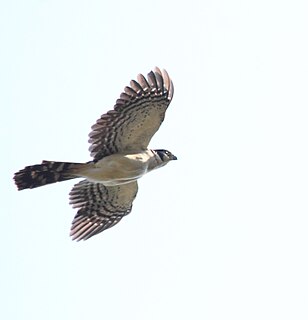
The collared forest falcon is a species of bird of prey in the family Falconidae. It is the largest member of the Micrastur genus and a common inhabitant of tropical rainforests in Latin America. Hiding in the dense forest canopy, they are a secretive bird often only recognized by their distinctive call. With a morphology or body type allowing them to be agile in their forested habitat, their diet comprises a wide variety of prey from smaller frogs to adult turkeys (2.7-3.2 kg).
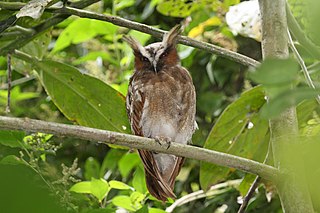
The crested owl is a species of owl in the family Strigidae. It is the only species (monotypic) in the genus Lophostrix. It is a resident bird and occurs in Central America and northern South America. It is a medium-sized owl, easily recognizable with its very long whitish ear tufts and otherwise darker appearance. It inhabits lowland rainforests and prefers old growth in proximity with water. The crested owl is a strictly nocturnal species, but very little is known about its behaviour.

The long-tailed manakin is a species of bird in the family Pipridae native to Central America where it inhabits both wet and dry tropical and subtropical forests. It is a small, plump bird about 10 centimetres (4 in) long. Males have black plumage with a blue back and a red crown, and the two central tail feathers are greatly elongated.. Females and juveniles are olive-green with paler underparts. At breeding time, males are involved in a cooperative lekking behaviour with a complex coordinated courtship dance. This is a fairly common species with a wide range, and the International Union for Conservation of Nature has rated its conservation status as being of "least concern".
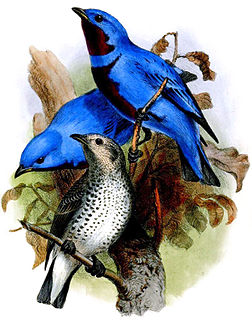
The lovely cotinga is a species of bird in the family Cotingidae. It is found in North and Central America from southern Mexico through Guatemala, Belize, Honduras and Nicaragua to Costa Rica with reports from western Panama. Its natural habitats are tropical moist lowland forests and heavily degraded former forest. The male is a bright turquoise blue while the female is greyish-brown with pale underparts. Because of its total population size and wide range, this species is not yet considered vulnerable.
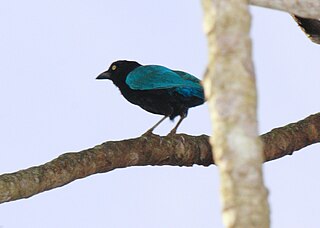
The San Blas jay is a species of bird in the family Corvidae. It is endemic to Mexico where its natural habitat is subtropical or tropical dry forests; it is a common species and has been rated as "least concern" by the IUCN.

The Yucatan jay is a species of bird in the family Corvidae, the crows and their allies. It is native to the Yucatán Peninsula where its habitats are subtropical or tropical dry forest, plantations and cleared areas at altitudes up to 250 m (820 ft). Adults are about 30 cm (12 in) long, black, with blue wings, mantle, and tail, black bills, yellow eye rings and legs. Immature birds have yellow bills. This is a common species of jay with a wide range and the International Union for Conservation of Nature has rated its conservation status as being of "least concern".
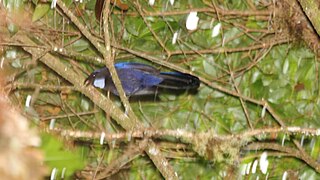
The silvery-throated jay is a species of bird in the family Corvidae. It is found in the Talamancan montane forests of Costa Rica and western Panama. The IUCN has rated its conservation status as being of "least concern".

The azure-hooded jay is a species of bird in the family Corvidae. It is found in Middle America. Its natural habitat is subtropical or tropical moist montane forest. This species is known to have four subspecies. It is 11 to 12 inches in length and is dark blue with a black head and upper chest. The back of the head and neck are sky blue with a white border.
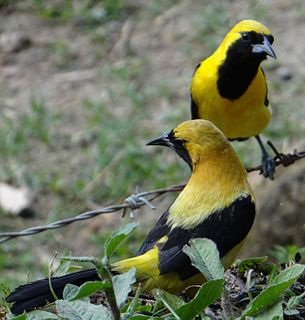
The yellow-backed oriole is a species of bird in the family Icteridae.

The olivaceous piculet is a species of bird in the family Picidae. Etymologically, piculet is as a double diminutive of the Latin picus, woodpecker, see also Picus. In Greek, δρύοψ is woodpecker, which shares its roots with δρῦς, 'tree'; 'oak' and Druids.

The black-headed trogon is a species of bird in the family Trogonidae. It is found in Belize, Costa Rica, El Salvador, Guatemala, Honduras, Mexico, and Nicaragua. Its natural habitats are subtropical or tropical dry forest, subtropical or tropical moist lowland forest, and heavily degraded former forest.

The mountain trogon, also known as the Mexican trogon, is a species of bird in the family Trogonidae. First described by William John Swainson in 1827, it is resident in Guatemala, Honduras, and Mexico and has occurred in El Salvador as a vagrant. Like all trogons, the mountain trogon is sexually dimorphic. The male is metallic green on the crown, nape, upperparts and chest, the latter separated from its bright red belly and vent by a narrow band of white. The female is warm brown on the head, upperparts and chest, separated from its paler brown lower chest and red belly and vent by a narrow white band.
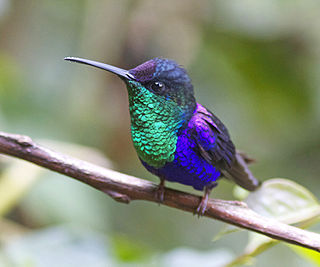
The crowned woodnymph is a species of bird in the hummingbird family Trochilidae. It is found in Belize and Guatemala to northern Peru. Its natural habitats are subtropical or tropical moist lowland forest, subtropical or tropical moist montane forest, and heavily degraded former forest.
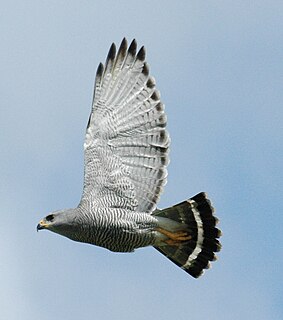
The gray hawk or Mexican goshawk is a smallish raptor found in open country and forest edges. It is sometimes placed in the genus Asturina as Asturina plagiata. The species was split by the American Ornithological Society (AOU) from the gray-lined hawk. The gray hawk is found from Costa Rica north into the southwestern United States.























